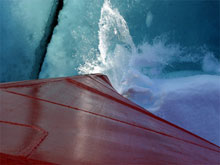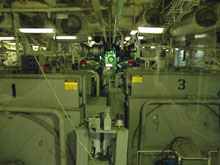
The US Coast Guard Cutter Healy breaks ice by forcing the ice down under its sloping bow. The hull is reinforced to withstand the impact, with up to 2-inch thick steel plates at critical areas. Click image for larger view.
Powering through Ice with the US Coast Guard Cutter Healy
July 17 , 2005
LTJG Taggart Irwin
Damage Control Assistant
Healy is designed as a world-class polar research vessel, capable of delivering a science party to high latitude destinations in both the Arctic and Antarctic. Polar missions include conducting scientific research, escorting other vessels otherwise incapable of traversing ice-covered waters, and transporting cargo and passengers. But what enables Healy and not other ships to power through the ice?
The Hull, The Ice, The Ocean
The Healy breaks ice by forcing the ice down under its sloping bow. The hull is reinforced to withstand the impact, with up to 2-inch thick steel plates at critical areas. The ship can maintain a steady 3 knots through almost 5 feet of ice, and can handle up to 8 feet by backing down and ramming. With over one million gallons of diesel and relatively fuel-efficient engines, the Healy is capable of traveling up to 16,000 nautical miles at 12 knots, achieving a maximum speed of 17 knots.
At the heart of Healy’s machinery plant are four 10,000 horsepower diesel engines connected to AC electric generators, each capable of producing nearly 8 megawatts of electricity- enough to power a small town. This power is generated at a high voltage (6600V) to propel the Healy forward and over the ice. To drive Healy through the water, the high voltage current from the diesel-generators powers two very large, 15,000 hp AC electric motors. These produce electric/magnetic fields that turn the propeller shafts. But that’s not all: before the power reaches the motors, it passes through devices known as cycloconverters. These alter the frequency of the electrical signal going to the motors to control speed. For added maneuverability, Healy has a bow thruster, which jets seawater to port or starboard, allowing the ship to establish and maintain a desired heading regardless of the navigational environment. Once the Healy is underway, the combination of high engine power and the forward momentum of the 420-foot Cutter keep the Healy moving through the water and ice.

Two of Healy’s four engines as viewed through the control room. Each 10,000 horsepower diesel engine is capable of producing nearly 8 megawatts of electricity, or enough to power a small town. Click image for larger view.
There is also a wide range of auxiliary equipment onboard: the engine cooling system, much like coolant for a car, involves two types of chemically-treated cooling fresh water which are in turn cooled by sea water drawn from the ocean. All of these water systems are powered by electric pumps, which are crucial for safeguarding the engines, motors, and much more. Boilers burn fuel to heat water into steam that is then circulated all around the ship for uses such as heating the crew’s berthing areas and some equipment. Healy uses evaporators to produce fresh, drinkable water by heating seawater with steam.
While the ocean is a wellspring of scientific knowledge, it carries with it very real hazards. Damage control and watertight integrity are a crucial element to the design of any modern vessel, especially one forging into the isolated and environmentally inhospitable Polar Regions. The key idea is “compartmentalization” – if Healy were to suffer a hull breach and begin flooding, the flow of water can be contained to a single space by means of large steel bulkheads that divide the ship into individual compartments. Passage between these bulkheads is possible through doors, hatches, and scuttles, many of which are also watertight as long as they are closed (or “secured”) and properly maintained.
An Unusual Cutter
Icebreakers are a very unique side of the Coast Guard’s fleet, providing a fantastic opportunity for the Coast Guard to interact on a very personal level with scientific groups such as the National Science Foundation (NSF), the National Oceanic and Atmospheric Administration (NOAA), and various international organizations and research groups. As a Coast Guard asset, however, Healy is always prepared to carry out more orthodox CG missions such as search and rescue.
Sign up for the Ocean Explorer E-mail Update List.
































